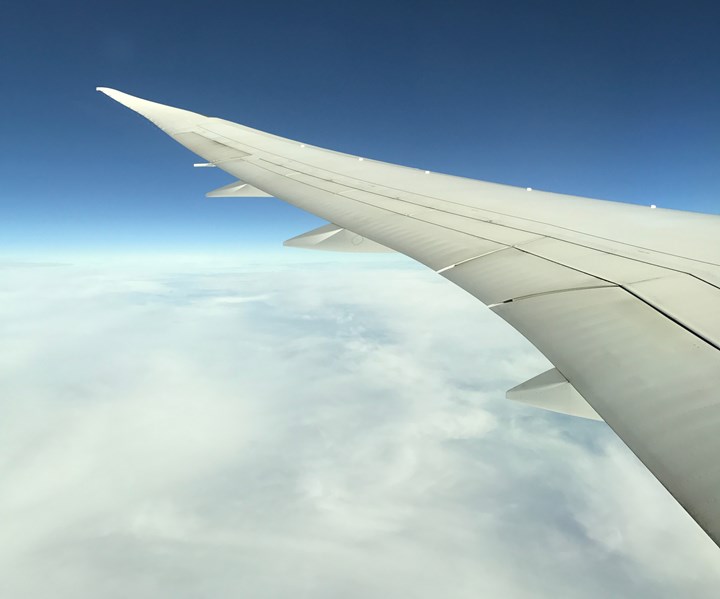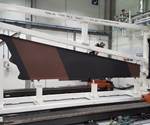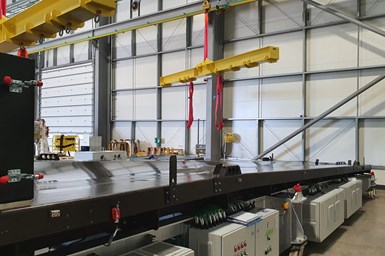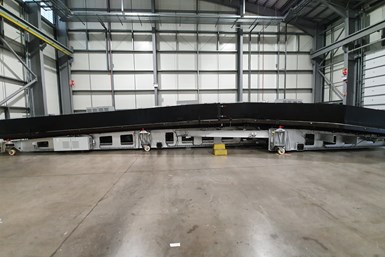
The throughput of composites manufacturing technologies used to fabricate wings for the A350 and 787 will not be adequate for next-generation single-aisle planes. Such programs, with an anticipated rate of at least 60 shipsets per month, will need faster, more economical processes. Airbus’ Wing of Tomorrow program is working on that. Program partner Spirit AeroSystems (Europe) is focusing on infusion of the lower wing skin. Source | CW
As Airbus (Toulouse, France) considers materials and process (M&P) combinations for future aircraft, one of the highest profile efforts it is leading is the Wing of Tomorrow (WOT) program. Launched in 2015 and based at the company’s wing technology center in Filton, U.K., WOT is designed to explore the best materials, manufacturing and assembly techniques, as well as new technologies in aerodynamics and wing architecture. It is comprised of a multifunctional team that will select and develop a range of innovations in preparation for full-scale demonstrations, all in pursuit of reduced equipment and tooling costs along with faster production throughputs — particularly for possible use in a high-volume, single-aisle commercial aircraft program.
Colin Mitchell, head of Wing of Industrial Architects and head of Industrial, Wing of Tomorrow at Airbus, says, "The Wing of Tomorrow program continues to be on track. There were some minor adaptations to the plan resulting from Airbus' involvement in the UK Government's program to build ventilators in the fight against COVID-19, but progress expectations have been exceeded in many cases during the relevant partnership/supplier lockdowns across the world.
"Airbus is an industry leader and Europe's key aerospace manufacturer. Our commitment to R&T and R&D is as strong as ever and the company maintains its support, not only for the Wing of Tomorrow program, but also to all the other priority development programs that will help protect the future of the company and the industry as a whole.”
Mitchell adds, "The Wing of Tomorrow program is developing numerous technologies and architecture options both internally and in the supplier/partner landscape. This will enable Airbus to make informed decisions when the time is right.”
Airbus has allocated Wing of Tomorrow work among several partners, with each focused on developing different M&P combinations for different structures. Airbus is working on the upper wing skin, wing box, wing box ribs, flaps and the joint of the folding wing tip (FWT). Spirit AeroSystems (Europe), in Prestwick, Scotland, is working on the lower wing skin, the fixed leading edge and a slat. GKN Aerospace (Redditch, U.K.) is working on the rear spar, the trailing edge and the wing box ribs (with Airbus). Also partnering with Airbus on WOT, particularly on prototype manufacturing, is the National Composites Centre (NCC, Bristol). Each of the structures under development is in various stages of maturity; this report will focus on the lower wing skin. CW will report on other structures in subsequent issues.
Infusion: A departure from the norm
The benchmark process for composite wing skin fabrication on the Airbus A350 and the Boeing 787, automated tape laying (ATL) of prepreg tapes, is attractive because it enables the placement of a large amount of material over a large area relatively quickly, especially if that large area is either uncontoured or modestly contoured. ATL, however, also requires autoclave cure, which consumes precious manufacturing time. For the 787 and the A350, which pre-pandemic were being manufactured at a rate of about 10 per month, such autoclave cure fits well into the production pace. Looking to the future, however, next-generation aircraft — for example, a new single-aisle aircraft to replace the A320, in Airbus’s case — might be manufactured at a rate of 60-100 month. An autoclave-dependent manufacturing process, the argument goes, would require a large capital investment and factory footprint to meet that rate and therefore make ATL unviable practically and economically.
It’s for this reason that out-of-autoclave (OOA) processes are being evaluated for WOT structures, with special attention being paid to wing skins. Each wing on an aircraft has two wing skins, one lower and one upper, that provide the largest aerodynamic surface on the plane. The inner surface of each skin includes a series of parallel stringers that run root-to-tip and provide structural support. Stringers ideally are co-cured with the skin, but can also be mechanically fastened. The skins and stringers surround and are attached to the wing ribs and the front and rear spar, which is also attached to the ribs and run the length of the wing. The spar is the primary structural member of the wing, bears the flight loads and supports the wing when the plane is on the ground.
Although the first composite wing skins — for the A350 and 787 — were made via ATL, the use of OOA processes is not new. The single-aisle Irkut (Moscow, Russia) MC-21 aircraft features wing skins fabricated via liquid resin infusion. Read more about that in CW’s, “Infused wing sheds light on aerocomposites future,” published in August 2018. The other aircraft that features an infused wing skin is the Airbus A220. Its wingskins are fabricated by Bombardier Aerospace (Montreal, Quebec) in Belfast, Northern Ireland, using infusion combined with autoclave consolidation. Spirit AeroSystems announced in late 2019 that it intends to acquire the Belfast plant, but that deal has not yet been finalized.
Liquid resin infusion has much going for it when it comes to wing skin fabrication. The primary benefits are OOA cure, the ability to co-cure skins and stringers, near net shape fabrication and the potential for economical manufacture at high rate (60-100 shipsets per month). Liquid resin infusion also has a couple things going against it — at least in principle. The most onerous challenge is potentially long on-tool time.
The full-scale 17-meter tool for the lower wing skin, just after delivery to Spirit AeroSystems (Europe) in Prestwick, Scotland. The tool uses specialized mold temperature control technology and features a semi-flexible membrane and heated tool lid. Source | Spirit AeroSystems (Europe)
Evolving materials, tooling and process technologies
As noted, the development of the infused lower wing skin is being conducted by Spirit AeroSystems at its Prestwick, U.K., facility. The effort is being led by Chris Hughes, head of advanced product development at the Prestwick facility, and Stevie Brown, head of Prestwick research and technology. Since early 2018, Spirit’s work on the infused wing skin has focused on the fabrication and testing of a 7-meter subscale prototype. By mid-July 2020, Spirit was in the process of migrating into the next phase of the program in the fabrication of a 17-meter full-scale demonstrator.
The 17-meter demonstrator represents the approximate shape and size of a lower wing skin for what would be, notionally, a new single-aisle commercial aircraft — a replacement for the A320. The maximum chord of the skin measures 3.3 meters, and 1.1 meters wide at the tip. Thickness of the skin laminate measures 5 millimeters near the tip and 30 millimeters at the skin’s interface with the main landing gear fittings.
The wing skin will be produced with a suite of technologies developed by Spirit AeroSystems called Intelligent Resin Infusion System (IRIS), comprised of specialized tooling, automated material deposition, integrated stringer forming and closely controlled process temperatures. At the heart of this system is an embedded tool-heating technology located close to the mold surface that uses low-voltage resistive heating located close to the mold surface to provide rapid and precise temperature control. The level of heating is achieved by controlling and moderating the power input. The carbon fiber tool includes an IML heated lid as well as a semi-flexible, reusable vacuum bag.
“There are multiple heating fields that are individually monitored and controlled. This enables each zone to operate at target temperatures throughout the infusion and cure cycle,” says Brown. “This is important as each zone of the part will require a different heat input based on the size and volume. It is an advanced heating system that is integral to the tool to allow for intimate contact with the part to reduce the power required and the cycle time.”
The dry reinforcements for the wing skin are supplied by Teijin Carbon Europe GmbH (Wuppertal, Germany), derived from that supplier’s line of intermediate modulus, 24k tow carbon fiber. Fiber formats, says Hughes, include unidirectional (UD) fabrics as well as biaxial and triaxial noncrimp fabrics (NCF). Glass fiber patches are also included for drill breakout and to protect against galvanic corrosion.
Lower wing skin tool, with heated lid on. The tool uses an integrated heating located close to the mold surface to provide rapid and precise temperature control. Source | Spirit AeroSystems (Europe)
“Spirit have worked with Teijin to select a number of NCF formats to balance structural performance with manufacturing cost,” says Hughes. “A percentage of the cover will be produced from UD, which can give improved structural performance and maximize the buy-to fly [ratio]. Use of these two material types will demonstrate the ability to infuse differing materials using the IRIS process.
The same Teijin NCF reinforcement can be found in the stringers, which will be manufactured via a bespoke continuous stringer forming machine developed by automation specialist Broetje-Automation GmbH (Rastede, Germany). The stringer forming machine will be capable of producing stringers with varying thickness, curvature and blade angles.
The resin system chosen for the wing skin is a single-component epoxy system from Solvay Composite Materials’ (Alpharetta, Ga., U.S.). Resin, Brown notes, will be delivered to the dry reinforcements via “multiple” injection points, carefully chosen to maximize injection speed and wetout. Injection equipment is being provided by Composite Integration Ltd. (Saltash, U.K.). As noted, the structure will be vacuum bagged with a semi-flexible, reusable bag, overtopped by a massive heated lid.
Time to fabricate
As of mid-July 2020, the 17-meter tool was in Prestwick for assessment by Hughes, Brown and their Spirit teammates. Spirit ultimately will transfer the the 17-meter tool to WOT partner NCC to fabricate the full-scale demonstrator in early 2021. The NCC will program and operate a new ply deposition machine under Spirit’s supervision, and conduct non-destructive inspection (NDI). All other operations: leveling, tool prep, stringer and bag placement, plumbing, operation of the tool and infusion equipment will be completed at NCC in isolation by Spirit.
Ply deposition at NCC will be performed with the Ultra High Rate Deposition Cell (UHRDC), a gantry-based robotic system that uses automation technology supplied by Güdel (Langenthal, Switzerland). This UHRDC will deploy two material handling systems for loading NCF fabrics into the skin tool. The first system, which NCC calls FibreFORM, is comprised of a dense array of suction cups that will pick and place cut NCF plies. The second system, called FibreROLL, rolls long plies onto a drum, and then unrolls them onto the tool. The below video illustrates these concepts.
Richard Oldfield, CEO of NCC, says, “Here at the NCC we are bringing together and hosting many of the organizations that make up the Airbus-led Wing of Tomorrow program. We’re playing a major role in developing and demonstrating the advanced manufacturing technology across the program and, as such, are able to provide strategic innovation advice to all of the partners involved.”
Oldfield continues, “We’re really excited to be working with Spirit on this part of the program and believe that technologies, such as the NCC’s Ultra High Rate Deposition cell, provide the best chance of meeting the rate, cost and quality requirements of the next generation of civil aviation aircraft wings, maintaining competitiveness in the U.K.”
The big question facing Spirit AeroSystems and NCC is one of throughput. To compete with autoclave-cured ATL-based processes, infusion will have to not only be more productive, but the wing skin that emerges from the process will have to be near net shape and require minimal finishing. To boost productivity, says Hughes, “we [Spirit] are collaborating with the National Composites Centre in Bristol who are in the process of commissioning a large-scale, carbon deposition machine. The machine will be capable of depositing NCF up to 5 meters in width. It has an automated ply trimmer as part of the cell and has a dry-fiber placement head.”
In terms of actual processing, the use of specialized mold temperature control technology, combined with the one-part resin system, flow media (from Airtech International, Huntington Beach, Calif., U.S.) and a caul sheet is expected to expedite resin take-up and infusion into the dry fibers. Further, resin will infuse the skin first and the stringers last. How long that process will take remains to be seen, but Brown notes that the 7-meter wing skin infused in about 4 hours; he expects the 17-meter skin will infuse in the same amount of time.
Regarding finishing, Hughes says that for the demonstrator, Spirit will produce net edge stringers and a portion of the trailing edge of the wing skin. “This is a key area of development going forward,” he says, “where we will work with the OEMs to balance dimensional and laminate quality requirements with production speed and cost.”
As noted, a potentially limiting factor of infusion is relatively long on-tool time for the material, which could become a bottleneck. Brown admits this is a concern, however, through the use of discrete event simulation and Spirit’s proprietary Trade Tool, the company has been able to model the sensitivities within the process to enable targeted development of automation and process control technologies to optimize the process.
“We estimate that the on-tool time is comparable to today’s prepreg AFP approach,” says Brown. “The laydown of the fabric for NCF is faster — wide blankets verses narrow tape for AFP — and the set-up is more time-consuming for infusion, and the infusion time itself must be added. But the key advantage is the deposition time for the NCF. On balance, the on-tool time should be comparable or reduced as we improve the deposition technology and infusion process.”
In any case, Hughes and Brown argue, Spirit AeroSystems estimates significant cost savings versus a traditional prepreg wing cover cured in an autoclave. “The production facility required to produce wing covers at rate 60 and above will be significantly smaller using the IRIS process with heated tooling, automated deposition of NCF ‘blankets’ and the continuous stringer forming machine,” Hughes contends. “Rate 60 demands production of a wing cover every 3 hours. If current technology were utilized, the numbers of ATL machines and autoclaves would drive very significant upfront costs and running costs.”
Related Content
Plant tour: Middle River Aerostructure Systems, Baltimore, Md., U.S.
The historic Martin Aircraft factory is advancing digitized automation for more sustainable production of composite aerostructures.
Read MoreThe potential for thermoplastic composite nacelles
Collins Aerospace draws on global team, decades of experience to demonstrate large, curved AFP and welded structures for the next generation of aircraft.
Read MorePEEK vs. PEKK vs. PAEK and continuous compression molding
Suppliers of thermoplastics and carbon fiber chime in regarding PEEK vs. PEKK, and now PAEK, as well as in-situ consolidation — the supply chain for thermoplastic tape composites continues to evolve.
Read MoreASCEND program update: Designing next-gen, high-rate auto and aerospace composites
GKN Aerospace, McLaren Automotive and U.K.-based partners share goals and progress aiming at high-rate, Industry 4.0-enabled, sustainable materials and processes.
Read MoreRead Next
Spirit AeroSystems collaborates on Wing of Tomorrow program
Spirit emphasizes use of modeling and simulation software for composite resin infusion technology.
Read MoreVIDEO: High-volume processing for fiberglass components
Cannon Ergos, a company specializing in high-ton presses and equipment for composites fabrication and plastics processing, displayed automotive and industrial components at CAMX 2024.
Read MoreDeveloping bonded composite repair for ships, offshore units
Bureau Veritas and industry partners issue guidelines and pave the way for certification via StrengthBond Offshore project.
Read More
























